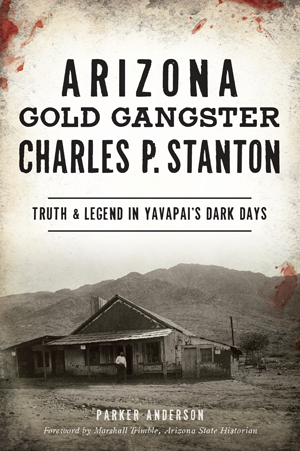
After last month’s discussion with Teresa Nordheim, our next victim—er, guest—on Crime Capsule is Parker Anderson, longtime Arizona historian and author of the brand-new Arizona Gold Gangster Charles P. Stanton: Truth & Legend in Yavapai’s Dark Days. Anderson’s book explores the legacy of one of Arizona’s most famous crime lords, and we’re delighted to have him join us this month.
CC: First things first, congratulations on your new book! Can you tell us how Arizona Gold Gangster came to be?
PA: I have lived in Yavapai County all my life, and had long heard the legend of Charles P. Stanton. From other historical research I have done in the past, I encountered his name in passing and things sounded a little “different” in some ways from the legend. Finally I decided to do a thorough research project on him from original surviving documents.
You’ve written for Arcadia/The History Press before. As a historian, what did you learn working on your previous books that you could apply to this one?
That it is always best to go right to surviving original sources if possible, i.e. newspapers, county records, etc. It is not always wise to assume that previous historians did all the work and got everything right, even though most would think that a reasonable assumption.
At heart, Arizona Gold Gangster is the story of one almost larger-than-life man. As you were researching and writing, how did you separate truth from legend and fact from myth?
It was easier than one would think. In many cases, the surviving primary sources were often directly contradictory with the legend, and in such cases, I think original sources are the most reliable. Some people think that if a legend has been around for generations, it has earned the right to be considered true, but I think that is absurd if it really isn’t true.
What kind of material did you use to tell your story? What were your sources?
County property records, old mining claims, court papers, old newspapers, etc. Yavapai County records are fairly well-preserved, unlike in some areas of the nation. Often sources such as these are ignored because so many historians borrow from each other, making the often-erroneous assumption that the last writer got it right. There is also a viewpoint that I don’t subscribe to—and which is showing signs of fading—that oral legends have earned the right to be considered accurate simply because they have survived for so long.

What kind of legacy does Stanton have today? What remains of his vast empire now?
His legacy is, sadly, only the legend, which depicts him as Satan incarnate, a human monster. I simply do not believe this is true, and presented my case in the book. Today, the town that bore his name is a ghost town. The site is now owned by the Lost Dutchman Mining Association, and they have turned it into, of all things, an RV park for their members!
You’ve written about Arizona many times before, but you’re a native Arizonan as well. Did any aspect of this story hit home, or did you have any personal connection to any part?
I used to live in the area—I spent part of my childhood in the towns of Congress and Yarnell, both not far from where the town of Stanton was. So I do have a soft spot for the whole area. There is a part of me that wishes my family had never left. But through my childhood, I heard local lore about the area, including the traditional legend of Stanton.
Last but not least, what’s your next project? Do you have any idea?
I am writing a book called Hidden History of Prescott for The History Press. Details to come, though I hope to explore early influences on the city of Prescott that are not talked about so much. I also have aspirations of eventually writing a biography of a once-prominent, early 20th-century stage actress who shall remain unnamed for now.

About the Book:
For generations, Arizonans have been fascinated with the story of Charles P. Stanton. The alleged crime boss and mass murderer oversaw a reign of terror in the small mining town that bore his name. Driven by greed, he stole ore, swindled mines away from their owners and bribed his way out of justice. Those who crossed him usually ended up dead. But are the legends actually true? Relying on original source material, including court documents and newspapers, Arizona historian Parker Anderson reveals the true story of Stanton for the first time and broaches the possibility that the mysterious Irish Lord may not have been guilty of the terrible crimes that folklore has attributed to him.



